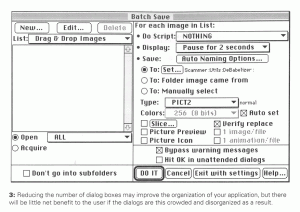- Brittleness
- Robustness
- Diversity
- “Niche” Computer Systems
- Downtime
- Meaningful Use
- Efficiency
- Anticryptography
- Color
- RHIO
- “Wrong Patient”
- Cognitive Friction
- Dialog-Box Rooms
- Ignore
- What’s in a word?
- ALLCAPS
- Layers
- Consistency
- Menu
- Cost Disease
- RAND
- PHR
- Model T
- Giveaway
- Skeuomorphism
- Icon
- Signal-to-Noise Ratio
- Anti-Data Pixels
- iPhones
- Suicide
- Anthropology
- Wireframes
- Fitts’s Law
- Kludge
- Ebola
- Pop-Up
- Clicks
- Bad Apple
- Testing
- Bold
- Point-and-Click
- Anti-User Pixels
- Flat
- Glucose
At the EDIS Symposium each year, a big question for attendees is “should we install the ED module of our hospital-wide information system (HIS), or should we install a ‘niche’ system that’s designed specifically for the ED?”
Traditional wisdom has it that the “niche” systems, also known as “best-of-breed,” will work better than the ED-specific module of a big HIS. This is true. Surveys by KLAS show this, and certainly my personal experiences with four or five different EDISs bears this out.
However, there are reasons why the ED module of a HIS can actually be better, at least in some ways, than a dedicated niche/best-of-breed ED system – integration. For instance, where I worked in the ED at Mercy Hospital of Pittsburgh (~60,000/year ED visits, Level I Trauma/Burn/tertiary care teaching center), we had Wellsoft, the KLAS top-ranked niche EDIS. We used it for tracking, nurse charting but not physician charting (we use Dictaphone EWS for physician charting), and a whole host of other purposes in the ED. It was extremely well-liked by all. However, the hospital was doing poorly (in financial terms) and it merged with University of Pittsburgh Medical Center, becoming UPMC Mercy. The ED was forced to abandon Wellsoft and adopt Cerner FirstNet, the ED tracking module of the UPMC-wide Cerner HIS. Users complained about this “downgrade” and of how “klunky” FirstNet was compared to Wellsoft – and indeed this is borne out by FirstNet having a much lower KLAS rating than Wellsoft.
Yet, FirstNet provides certain major advantages over Wellsoft. Once we installed FirstNet, it provided instant integrated access to all of the electronic medical records of the entire UPMC system. You just need to double-click a name on the tracking board, and you can then browse the electronic medical records. This goes a long way to mitigate user frustration at poor design, poor user interaction, frequent planned downtime (Wellsoft almost never went down, and never on a planned basis), and lack of some of Wellsoft’s functions. To credit the local UPMC/Cerner staff, they worked very hard to duplicate some of the Wellsoft functions we lost. As a result, our version of FirstNet (but not what you buy when you get FirstNet “out of the box”) provides many of those Wellsoft functions (e.g., icons for “Discharge:OK” “Discharge: Treatment Needed Prior to Dsicharge” and “Discharge:Hold” as well as a means of tracking pages to consultants, with a timed reminder for the secretary to page again) we used all the time.
Related to this, consider this quote by Jakob Nielsen from the foreword to Designing Visual Interfaces:
Would you want to live in a house where the bedroom was painted in an ugly combination of brown and purple? Probably not, but you may spend more time looking at the visual interface elements of your favorite software than you do looking at your bedroom walls.
In the bedroom wall example, people might buy the house anyway and then paint over the wall with a more agreeable color. This example leads me to consider an excuse some developers have for not providing a satisfactory visual interface to their products: “the user can just customize the design to his or her individual taste!” Leaving the design to the users is the ultimate abdication of the designer’s responsibility to provide a quality product, and many studies have shown that users are in fact very poor designers and often customize their interface in ways that are detrimental to their productivity (e.g., by using color combinations that are known to cause reduced readability of screen text). Even though there are often reasons to allow users to customize some aspects of their environment, it is absolutely essential for the designer to give the users a carefully thought-out set of defaults to start out with.
ED modules provided by HIS vendors (in fact, everything provided by HIS vendors) also reminds me of “If operating systems were airlines: Unix Express” quoted in Healthcare IT – Educate Yourself.
Not all HIS ED modules have this advantage of tight integration, however. Conemaugh Memorial Medical Center in Johnstown, PA uses McKesson as their HIS. McKesson has an electronic medical record system called CarePortal where you can look up medical records. McKesson also has an ED tracking system. For whatever reason – and I suspect that an even poorer design/user interaction design than FirstNet is a major part of it – I could only find one emergency physician who used the tracking board. She had used the McKesson tracking board at another ED while in medical school. She found it marginally useful, as she could use it to look up labs quickly.
Unlike Cerner FirstNet, the McKesson tracking board is not integrated with McKesson CarePortal, the electronic medical record system. You have to leave the tracking board and switch to a separate application to search for and find medical records. This kind of poor integration – found in a fair number of HIS modules, and in some cases, due to the problems of acquiring products, rather than developing them in-house. This lack of integration, this collage-ness, negates much of the advantages of the purported “integration” of an HIS ED module.( I think of how children will cut pictures out of a magazine and paste them onto a piece of paper as a collage, with no real integration, as opposed to my daughter, who goes to a Waldorf school, and is always taught to create drawings from scratch, and even at age 10, is now a much more talented artist than me or my wife.)
Niche ED systems can be integrated with HIS functions, but each interface costs money (price range I’ve heard is $5,000-$25,000 per interface) and eats up the time of the hospital’s IT staff. And the HIS vendor has no real incentive to provide interfaces for a competing product, so their cooperation is often grudging at best; sometimes the HIS vendor will simply refuse to interface. And, sometimes the interfaces are klunky, for example, when you click on the “lab” column for a patient’s row, you see an unparsed text display. (See Computers in the ED 8 for an example.)
Another advantage of the niche EDIS products is their abstraction and simplicity. Niche ED tracking boards provide the functions needed by different clinical personnel: docs, nurses, techs, secretaries. That means that the screen includes a fair number of things that are irrelevant to any particular user. But still, on the Wellsoft screen, I use (or at least have some interest in) about 3/4 or more of what I see on the screen. But the FirstNet screen, and tracking screens for most other HIS vendors, have a vast number of things irrelevant to ED users. I only use about 1/3 of the items on the FirstNet tracking screen. Indeed, I have no idea what about half of the items on the screen and the menus are for – and neither do the techs, nurses, other docs, or secretaries I’ve asked. They are just irrelevant to the ED. The FirstNet cluttered screen, with many more opportunities to accidentally click on the wrong thing, is intimidating for new users, and much harder to learn than WellSoft. We also know that cluttered screens slow people down, so FirstNet is less efficient than Wellsoft.
This is well-reflected in the user interaction design literature. An early study of text-based computer-aided education systems showed that a crowded screen slowed readers by 34%, and this effect was confirmed in a more recent study. Another study shows that layout of a screen makes a major difference on mental workload (and thus, efficiency and medical error). Usability.gov (an excellent site for usability information) lists cluttered screens as a 5/5 importance for screen design. MIT has even developed algorithms and computer programs to objectively measure clutter on a computer screen.
The figures in this post are from Mullet and Sano’s landmark book, Designing Visual Interfaces: Communication Oriented Techniques Although the second illustration is an example of an early Macintosh program, the design problem it evinces are pervasive in medical software, and represent some of the problems seen in HIS ED modules compared with “niche” ED products.
So, what’s the bottom line? Should you go for a niche ED system, or install the ED module of your HIS vendor? As usual, “it depends” is a good answer. It depends on the quality of the niche ED system, the quality of the HIS’s ED module (and its level of integration, which is usually its sole advantage), and whether you’ll be able to create the interfaces to make the niche ED system truly an integrated part of your hospital’s overall IT configuration.




